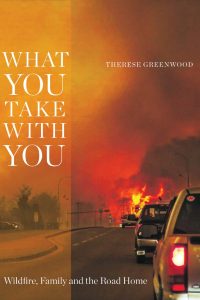Forty years after the Titanic sank, newspaperman Walter Lord tracked down survivors to ask what they took as they headed for the lifeboats. Lord recited the grab bag of mementos in his 1955 bestseller A Night To Remember. One brought a Bible, another a pistol. There were pocketfuls of cigars or cookies, fur coats, a sapphire necklace and a music box that played the Portuguese tango. One Toronto passenger retrieved three oranges but left behind a tin box containing $200,000 in bonds.
Author Therese Greenwood calls this “telescoping,” a phenomenon experienced by people under stress when their vision tunnels to objects literally in front of them. Greenwood’s What You Take With You explores this intriguing theme in the million-acre Fort McMurray fire, a near-disaster of Titanic proportions.
“Everyone tells me what they would pack if they were caught in a similar situation, usually baby and wedding photos, something sentimental,” writes Greenwood. “The younger ones mention laptop computers, hard drives, phones. ‘My phone is my life,’ they say. What you think you will pack as you look around your comfortable living room and what you snatch when smoke chokes the air and flames lick the sky are entirely different.”
On May 3, 2016 residents were ordered to drop everything and flee as flames spread through Fort McMurray at the rate of ninety feet a minute. There is one road out of the city. Greenwood lost her Riverview Heights home but notes residents count themselves lucky. “I’m still afraid of dying in a fire,” she writes.
She fled the inferno to the jolly tinkling of bells. “Do I hear sleigh bells?” her husband asked: “‘I packed my grandfather’s sleigh bells.’ ‘Smart thinking,’ Steve said. ‘Sleigh bells will come in handy today.’ It was thirty-four degrees Celsius inside the car.”
Greenwood also retrieved a family Bible, two cans of club soda, bank statements, a rolling pin and chipped, foot-high plaster statue of Saint Therese, yoghurt, a chrome-plated pen and two guitars: “You should have let them burn,” her sister said. “I would have thrown them into the flames.” Lost were four generations of family photos and an urn containing her father-in-law’s ashes.
“Driveways and front lawns were filled with scurrying people stowing suitcases, laundry hampers, plastic bins and diaper bags into trucks and vans and cars,” Greenwood writes. She recalls children clutching stuffed animals, and how traffic slowed to a dead stop right by the local cemetery, “ironically”.
Greenwood is part memoirist, part police reporter, skillfully weaving anecdotes from the day a whole city nearly burned to the ground. She remembers canned music on the radio station – announcers had joined the evacuation – and a local donut shop emptying shelves as giveaways. Just because the business was to burn was no reason to waste donuts. “Every vehicle on the road that day contained its own story,” she writes.
What You Take with You: Wildfire, Family and the Road Home, by Therese Greenwood; University of Alberta Press; 160 pages; ISBN 9781-77212-4491; $24.99






